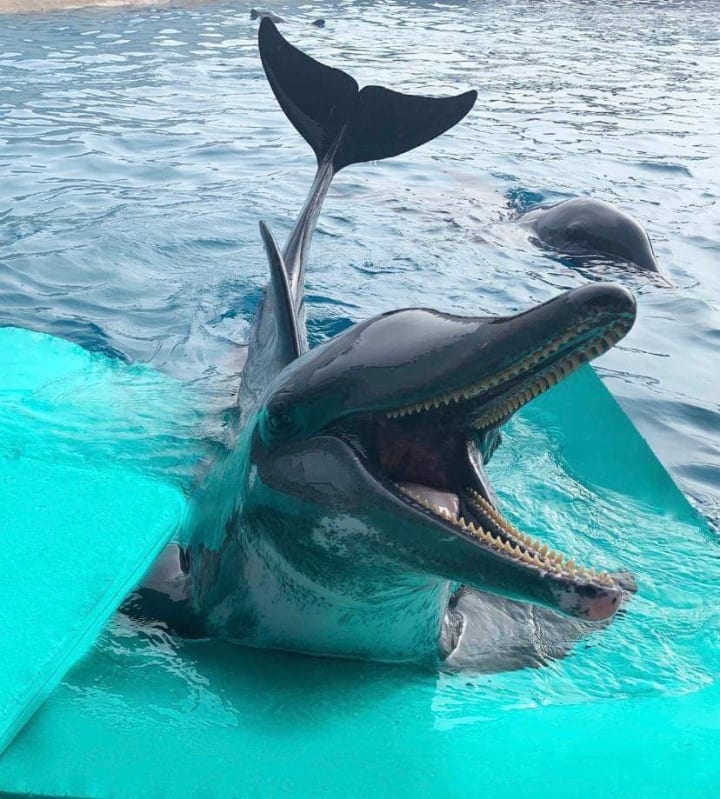

Dolphins are highly-intelligent and charismatic animals that are known to come to the rescue of people stranded in the water.īesides having incredible personalities, dolphins are also excellent swimmers and can reach speeds of over 18 miles an hour!
#DOLPHIN TEETH FULL#
Note the length of their rostrum, the curve of the fin, and any surface behaviours, such as the full body leap! Learn more about the dolphin and porpoise species in B.C.Dolphins have been fascinating human beings for ages. Distinguishing between the two just takes a bit of practice. They propose that dolphins have not evolved this high frequency echolocation because they employ other strategies, such as large group size or incredible speed, to avoid killer whale predation.įrom teeth to acoustics, dolphins and porpoises are indeed very different animals. Their theory is that porpoise echolocation evolved this way to avoid killer whale predation- essentially staying “under the radar” by making sounds killer whales cannot hear. A recent study in the journal PLOS ONE by Beedholm and colleagues showed that porpoises produce high frequency clicks that are restricted to a narrow band of frequencies, while those of a dolphin are not. Conversely, porpoises vocalize at a much higher range that we simply can’t hear. If you were to drop a hydrophone in the water around dolphins, you would be able to hear a cacophony of sound (listen to them here: Pacific white sided dolphin sound). Dolphins vocalize in a range audible to the human ear. rarely leap fully out of the water, while this is a behaviour that is observed regularly in dolphins, particularly the common Pacific white-sides seen along the coast.Īcoustically dolphins and porpoises differ quite a bit too. Additionally, Dall’s and harbour porpoises in B.C. Dolphins also tend to have a longer rostrum (the pointy ‘beak’ part of their face), while porpoises have a much shorter one, although there are definitely a few exceptions this this rule (including the non-existant rostrum of the Risso’s dolphin!). While not a hard and fast rule, dolphins usually have a more curved dorsal fin, while porpoises have a more triangular one.


On the water, there are a few other morphological traits that can help you distinguish a dolphin from a porpoise. After all, dolphins and porpoises don’t go about flashing their pearly whites! While this distinction may be apparent on a skull in a museum, it’s a tricky one to make in the field. Dolphins all have cone-shaped teeth, whereas porpoises have flat, spade- shaped teeth. The main distinguishing feature is actually their teeth. Oceanic dolphins, however, belong to the large Delphinidae family, which consists of at least 36 species worldwide! In B.C., eight species of delphinids have been recorded, including killer whales (the world’s largest dolphin), Pacific white sided dolphins, Risso’s dolphins, Northern right whale dolphins, false killer whales, long-beaked common dolphins, striped dolphins, and pilot whales (possible).ĭespite their different evolutionary histories, the two families have developed such similar body plans that often we can’t tell them apart from a quick glance. waters ( Dall’s porpoises and harbour porpoise). There are only six species of porpoises in the entire world, two of which live in B.C. Porpoises belong to the Phocoenidae family. In fact, as the Encyclopedia of Marine Mammals points out, porpoises and dolphins are “as different as horses and cows or cats and dogs”. It’s not just a difference in colloquial name, dolphins and porpoises are actually entirely different families of cetaceans. Even the names are often used interchangeably in everyday language. It’s plain to see how easy it is to mix-up many dolphin and porpoise species: they have similar characteristics including size, colouration and behaviour.

Dolphin or porpoise? Porpoise or dolphin? What’s the difference? It’s probably the most common identification mistake made when it comes to cetaceans on the coast of B.C.


 0 kommentar(er)
0 kommentar(er)
